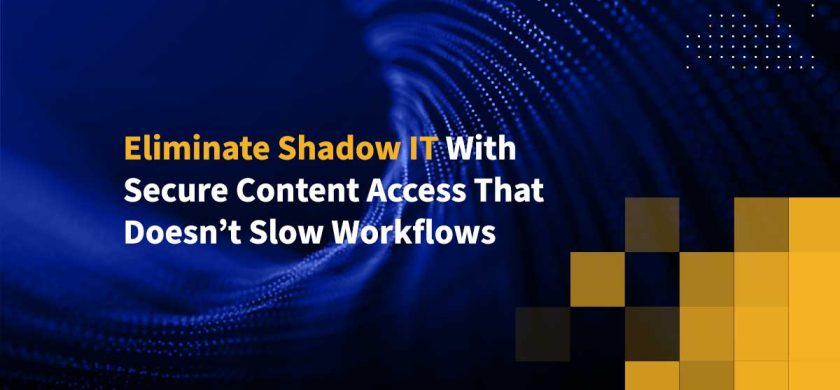
Eliminate Shadow IT With Secure Content Access That Doesn’t Slow Workflows
Securing sensitive data cannot sacrifice the simplicity of sharing it, otherwise users will circumvent the security. Users expect easy online access to the sensitive information they need to get work done. For them, the cloud is a panacea and a privilege. For CISOs, the cloud is a double-edged sword. Every minute and penny saved on the cloud comes at the price of increased risk. However, if you make the mistake of providing a complex channel for sharing information securely, users will seek out simple, insecure alternatives to accomplish their goals—building their own shadow IT out of easily accessible, consumer cloud applications.
Take Back Control of Your Data With Vendor Risk Management
Read NowCISOs must enable secure file sharing that balances the protection of sensitive content with the overwhelming need to share it, easing access while preventing breaches, ensuring privacy alongside transparency, and adhering to complex regulations without getting in the way of efficient communication. Each trade-off entails risks. This blog series explores these trade-offs and offers six guiding principles for creating a secure content sharing channel that enables work across the extended enterprise and protects your most sensitive digital assets.

In my last blog post, I discussed the challenge organizations have in providing easy access to sensitive content, but also ensuring that content is shared with complete confidentiality. Today, I’ll explore how organizations can eliminate shadow IT with a secure communication channel that shares sensitive content efficiently.
Simplicity Is Just As Important As Security
Every frustrated employee who takes IT into his or her own hands to get work done increases the risk of a breach, leaving the CISO responsible. Alternatively, blocking common consumer cloud services runs the risk of alienating everyone with complex communication processes. You must provide a secure communication channel for sharing sensitive content that is also incredibly simple and easy to use. Simplicity is just as important as security.
Enterprise Application Plugins Ensure Security and Simplicity
Users share content from a wide array of applications: email, Web browsers, office apps, mobile apps, and enterprise apps. Your secure content sharing channel must extend to every one of these endpoints. This can be achieved with plugins for each application that route content sharing through your secure channel. Enterprise application and Microsoft Office plugins make sending, receiving, saving and retrieving sensitive content as easy as clicking a button inside each target application. Once you have made it simple to share sensitive content securely, then you can shut down the alternatives with confidence. Restrict sharing to authorized applications by controlling software installation and deploy a cloud access security broker (CASB) to block unauthorized cloud services.
In my next post, I’ll discuss how CISOs can protect their organizations from a breach once they control every file saved and retrieved from every enterprise content repository. With enterprise content integration, organizations create a secure inner perimeter around their most valuable digital assets that complement a secure external perimeter.
To learn more about how your organization can eliminate shadow IT with a secure communication channel that shares sensitive content efficiently, schedule a custom demo of Kiteworks today.
Frequently Asked Questions
Third-party risk management is a strategy that organizations implement to identify, assess, and mitigate risks associated with their interactions with third-party vendors, suppliers, or partners. These risks can range from data breaches and security threats to compliance issues and operational disruptions. The process typically involves conducting due diligence before engaging with a third party, continuously monitoring the third party's activities and performance, and implementing controls to manage identified risks. The goal is to ensure that the third party's actions or failures do not negatively impact the organization's operations, reputation, or legal obligations.
Third-party risk management is crucial because it helps to identify, assess, and mitigate the risks associated with third-party relationships. This can include cybersecurity threats, compliance issues, operational risks, and reputational damage.
Policy controls are essential in third-party risk management as they establish clear expectations for third-party behavior, data handling, and security practices. They help mitigate the risk of security incidents by defining acceptable actions, and ensure third parties comply with relevant laws, regulations, and industry standards. Further, policy controls provide a foundation for monitoring third-party activities and enforcing compliance, allowing the organization to take appropriate action in case of policy violations. Thus, policy controls serve as a critical framework for managing third-party risks effectively.
Audit logs are integral to third-party risk management as they offer a comprehensive record of all third-party activities within your systems. They aid in identifying potential risks by highlighting unusual or suspicious activities, serve as a crucial resource during incident response and forensic investigations, and help ensure regulatory compliance by providing proof of effective security measures and third-party monitoring. In addition, they foster a culture of accountability and transparency among third parties, deterring malicious activities and encouraging adherence to security policies.
Kiteworks helps with third-party risk management by providing a secure platform for sharing and managing sensitive content. The platform is designed to control, track, and secure sensitive content that moves within, into, and out of an organization, significantly improving risk management. Kiteworks also provides two levels of email encryption, Enterprise and Email Protection Gateway (EPG), to secure sensitive email communications. This helps to protect against third-party risks associated with email communication.
Additional Resources
- Blog PostProtect Your IP with Complete Visibility into Every Sensitive File Exchange
- Case StudyCase Study – Cartes Bancaires
- Case StudyCase Study – MinterEllison
- KitetoonsThe Cloud
- Blog PostThe Dark at the Top of the Stairs—CISO Leadership

